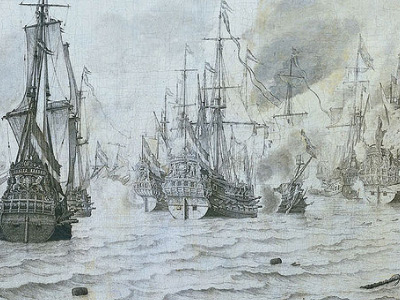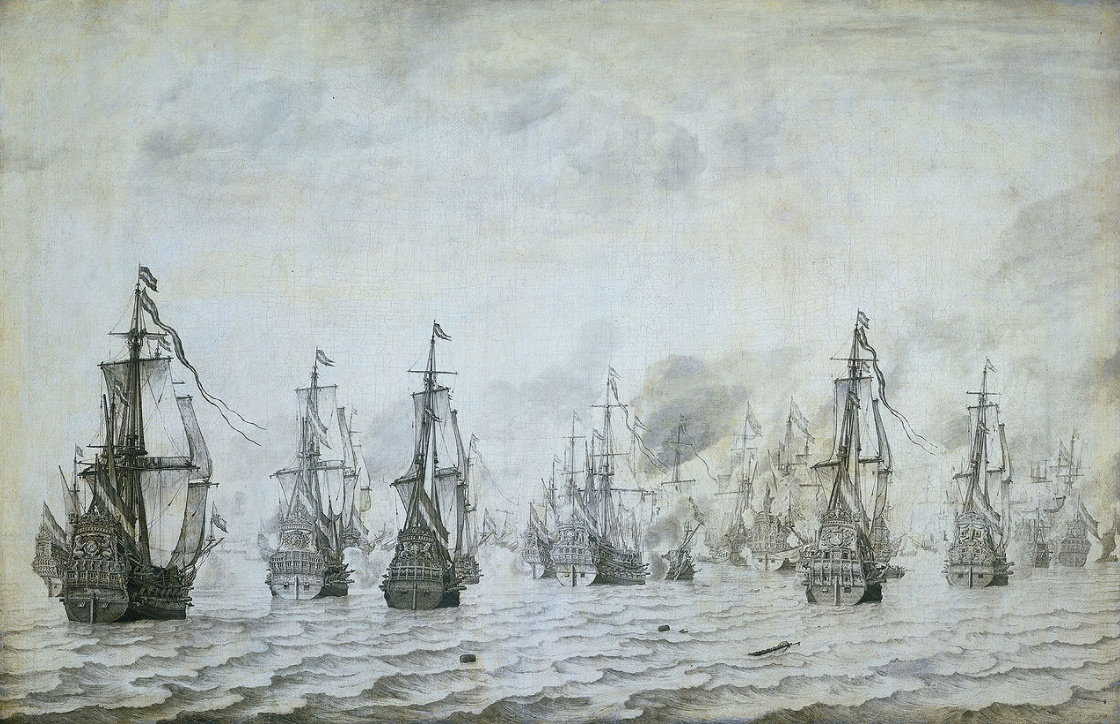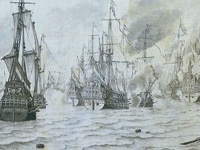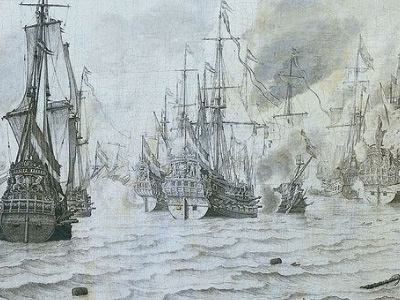Eighty Years' War (1568–1648)

Franco-Dutch Alliance (1635–1640)
While the peace negotiations had been dragging on, events elsewhere in Europe of course had not stood still. While Spain was busy fighting the Mantuan war, the Swedes had intervened in the Thirty Years' War in Germany under Gustavus Adolphus in 1630, supported by French and Dutch The Dutch Republic was a confederation that existed from 1579, during the Dutch Revolt, to 1795. It was a predecessor state of the Netherlands and the first fully independent Dutch nation state. Although the state was small and contained only around 1.5 million inhabitants, it controlled a worldwide network of seafaring trade routes. The income from this trade allowed the Dutch Republic to compete militarily against much larger countries. It amassed a huge fleet of 2,000 ships, initially larger than the fleets of England and France combined. subsidies. The Swedes used the new Dutch infantry tactics (enhanced with improved cavalry tactics) with much more success against the Imperialist forces than the German Protestants had done and so gained a number of important successes, turning the tide in the war. However, once its war with Italy ended in 1631, Spain
The Dutch Republic was a confederation that existed from 1579, during the Dutch Revolt, to 1795. It was a predecessor state of the Netherlands and the first fully independent Dutch nation state. Although the state was small and contained only around 1.5 million inhabitants, it controlled a worldwide network of seafaring trade routes. The income from this trade allowed the Dutch Republic to compete militarily against much larger countries. It amassed a huge fleet of 2,000 ships, initially larger than the fleets of England and France combined. subsidies. The Swedes used the new Dutch infantry tactics (enhanced with improved cavalry tactics) with much more success against the Imperialist forces than the German Protestants had done and so gained a number of important successes, turning the tide in the war. However, once its war with Italy ended in 1631, Spain The Spanish Empire was a colonial empire governed by Spain and its predecessor states between 1492 and 1976. One of the largest empires in history, it was the first to usher the European Age of Discovery and achieve a global scale, controlling vast territory. It was one of the most powerful empires of the early modern period, reaching its maximum extent in the 18th century. was able to build its forces in the northern theatre of war up to strength again. The Cardinal-Infante brought a strong army up, by way of the Spanish Road, and at the Battle of Nördlingen (1634) this army, combined with Imperialist forces, using the traditional Spanish tercio tactics, decisively defeated the Swedes. He then marched immediately on Brussels, where he succeeded the old Infanta Isabella who had died in December 1633. Spain's strength in the Southern Netherlands was now appreciably enhanced.
The Spanish Empire was a colonial empire governed by Spain and its predecessor states between 1492 and 1976. One of the largest empires in history, it was the first to usher the European Age of Discovery and achieve a global scale, controlling vast territory. It was one of the most powerful empires of the early modern period, reaching its maximum extent in the 18th century. was able to build its forces in the northern theatre of war up to strength again. The Cardinal-Infante brought a strong army up, by way of the Spanish Road, and at the Battle of Nördlingen (1634) this army, combined with Imperialist forces, using the traditional Spanish tercio tactics, decisively defeated the Swedes. He then marched immediately on Brussels, where he succeeded the old Infanta Isabella who had died in December 1633. Spain's strength in the Southern Netherlands was now appreciably enhanced.

The naval battle against the Spanish near Dunkerque, 18 February 1639

The naval battle against the Spanish near Dunkerque, 18 February 1639
( Click image to enlarge)
The Dutch, now with no prospect of peace with Spain, and faced with a resurgent Spanish force, decided to take the French overtures for an offensive alliance against Spain more seriously. This change in strategic policy was accompanied by a political sea-change within the Republic. The peace party around Amsterdam objected to the clause in the proposed treaty with France The Kingdom of France is the historiographical name or umbrella term given to various political entities of France in the medieval and early modern period. It was one of the most powerful states in Europe since the High Middle Ages. It was also an early colonial power, with possessions around the world. Colonial conflicts with Great Britain led to the loss of much of its North American holdings by 1763. The Kingdom of France adopted a written constitution in 1791, but the Kingdom was abolished a year later and replaced with the First French Republic. that bound the Republic's hands by prohibiting the conclusion of a separate peace with Spain. This would shackle the Republic to French policies and so constrain its independence. The resistance to the French alliance by the moderate regents caused a rupture in the relations with the stadtholder. Henceforth Frederick Henry would be much more closely aligned with the radical Counter-Remonstrants who supported the alliance. This political shift promoted the concentration of power and influence in the Republic in the hands of a small group of the stadtholder's favourites. These were the members of the several secrete besognes (secret committees) to which the States General more and more entrusted the conduct of diplomatic and military affairs. Unfortunately, this shift to secret policy-making by a few trusted courtiers also opened the way for foreign diplomats to influence policy-making with bribes. Some members of the inner circle performed prodigies of corruption. For instance, Cornelis Musch, the griffier (clerk) of the States General received 20,000 livres for his services in pushing the French treaty through from Cardinal Richelieu, while the pliable Grand Pensionary Jacob Cats (who had succeeded Adriaan Pauw, the leader of the opposition against the alliance) received 6,000 livres.
The Kingdom of France is the historiographical name or umbrella term given to various political entities of France in the medieval and early modern period. It was one of the most powerful states in Europe since the High Middle Ages. It was also an early colonial power, with possessions around the world. Colonial conflicts with Great Britain led to the loss of much of its North American holdings by 1763. The Kingdom of France adopted a written constitution in 1791, but the Kingdom was abolished a year later and replaced with the First French Republic. that bound the Republic's hands by prohibiting the conclusion of a separate peace with Spain. This would shackle the Republic to French policies and so constrain its independence. The resistance to the French alliance by the moderate regents caused a rupture in the relations with the stadtholder. Henceforth Frederick Henry would be much more closely aligned with the radical Counter-Remonstrants who supported the alliance. This political shift promoted the concentration of power and influence in the Republic in the hands of a small group of the stadtholder's favourites. These were the members of the several secrete besognes (secret committees) to which the States General more and more entrusted the conduct of diplomatic and military affairs. Unfortunately, this shift to secret policy-making by a few trusted courtiers also opened the way for foreign diplomats to influence policy-making with bribes. Some members of the inner circle performed prodigies of corruption. For instance, Cornelis Musch, the griffier (clerk) of the States General received 20,000 livres for his services in pushing the French treaty through from Cardinal Richelieu, while the pliable Grand Pensionary Jacob Cats (who had succeeded Adriaan Pauw, the leader of the opposition against the alliance) received 6,000 livres.
The Treaty of Alliance that was signed in Paris, in February 1635, committed the Republic to invade the Spanish Netherlands simultaneously with France later that year. The treaty previewed a partitioning of the Spanish Netherlands between the two invaders. If the inhabitants would rise against Spain, the Southern Netherlands would be afforded independence on the model of the Cantons of Switzerland, though with the Flemish seacoast, Namur and Thionville annexed by France, and Breda, Geldern and Hulst going to the Republic. If the inhabitants resisted, the country would be partitioned outright, with the Francophone provinces and western Flanders going to France, and the remainder to the Republic. The latter partitioning opened the prospect that Antwerp would be re-united with the Republic, and the Scheldt reopened for trade in that city, something Amsterdam was very much opposed to. The treaty also provided that the Catholic religion would be preserved in its entirety in the provinces to be apportioned to the Republic. This provision was understandable from the French point of view, as the French government had recently suppressed the Huguenots in their strongpoint of La Rochelle (with support of the Republic), and generally was reducing Protestant privileges. It enraged the radical Calvinists in the Republic, however. The treaty was not popular in the Republic for those reasons.
Dividing up the Spanish Netherlands proved more difficult than foreseen. Olivares had drawn up a strategy for this two-front war that proved very effective. Spain went on the defensive against the French forces that invaded in May 1635 and successfully held them at bay. The Cardinal-Infante brought his full offensive forces to bear on the Dutch, however, in hopes of knocking them out of the war in an early stage, after which France would soon come to terms herself, it was hoped. The Army of Flanders now again numbered 70,000 men, at least at parity with the Dutch forces. Once the force of the double invasion by France and the Republic had been broken, these troops emerged from their fortresses and attacked the recently conquered Dutch areas in a pincer movement. In July 1635 Spanish troops from Geldern captured the strategically essential fortress of the Schenkenschans. This was situated on an island in the Rhine near Cleves and dominated the "back door" into the Dutch heartland along the north bank of the river Rhine. Cleves itself was soon captured by a combined Imperialist-Spanish force and Spanish forces overran the Meierij.
The Republic could not let the capture of the Schenkenschans stand. Frederick Henry therefore concentrated a huge force to besiege the fortress even during the winter months of 1635. Spain held tenaciously on to the fortress and its strategic corridor through Cleves. She hoped that the pressure on this strategic point, and the threat of unhindered invasion of Gelderland and Utrecht, would force the Republic to give in. The planned Spanish invasion never materialised, however, as the stadtholder forced the surrender of the Spanish garrison in Schenkenschans in April 1636. This was a severe blow for Spain.
Advertisement

These books are available for download with iBooks on your Mac or iOS device, and with iTunes on your computer. Books can be read with iBooks on your Mac or iOS device.

These books are available for download with iBooks on your Mac or iOS device, and with iTunes on your computer. Books can be read with iBooks on your Mac or iOS device.
( Click image to enlarge)
The next year, thanks to the fact that the Cardinal-Infante shifted the focus of his campaign to the French border in that year, Frederick Henry managed to recapture Breda with a relatively small force, at the successful fourth Siege of Breda, (21 July–11 October 1637). This operation, which engaged his forces for a full season, was to be his last success for a long time, as the peace party in the Republic, over his objections, managed to cut war expenditure and shrink the size of the Dutch army. These economies were pushed through despite the fact that the economic situation in the Republic had improved appreciably in the 1630s, following the economic slump of the 1620s caused by the Spanish embargoes. The Spanish river blockade had ended in 1629. The end of the Polish–Swedish War in 1629 ended the disruption of Dutch Baltic trade. The outbreak of the Franco-Spanish War (1635) closed the alternate trade route through France for Flemish exports, forcing the South to pay the heavy Dutch wartime tariffs. Increased German demand for foodstuffs and military supplies as a consequence of military developments in that country, contributed to the economic boom in the Republic, as did successes of the VOC in the Indies and the WIC in the Americas (where the WIC had gained a foothold in Portuguese Brazil after its 1630 invasion, and now conducted a thriving sugar trade). The boom generated much income and savings, but there were few investment possibilities in trade, due to the persisting Spanish trade embargoes. As a consequence, the Republic experienced a number of speculative bubbles in housing, land (the lakes in North Holland were drained during this period) and, notoriously, tulips. Despite this economic upswing, which translated into increased fiscal revenues, the Dutch regents showed little enthusiasm for maintaining the high level of military expenditures of the middle 1630s. The échec of the Battle of Kallo of June 1638 did little to get more support for Frederick Henry's campaigns in the next few years. These proved unsuccessful; his colleague-in-arms Hendrik Casimir, the Frisian stadtholder died in battle during the unsuccessful siege of Hulst in 1640.
However, the Republic gained great victories at other locations. The war with France had closed the Spanish Road for Spain, making it difficult to bring up reinforcements from Italy. Olivares therefore decided to send 20,000 troops by sea from Spain in a large armada. This fleet was destroyed by the Dutch navy under Maarten Tromp and Witte Corneliszoon de With in the Battle of the Downs of 31 October 1639. This left little doubt that the Republic now possessed the strongest navy in the world, also because the Royal Navy was forced to stand by impotently while the battle raged in English territorial waters.
HISTORY

RESOURCES
This article uses material from the Wikipedia article "Eighty Years' War (1568–1648)", which is released under the Creative Commons Attribution-Share-Alike License 3.0.
© Stories Preschool. All Rights Reserved.









